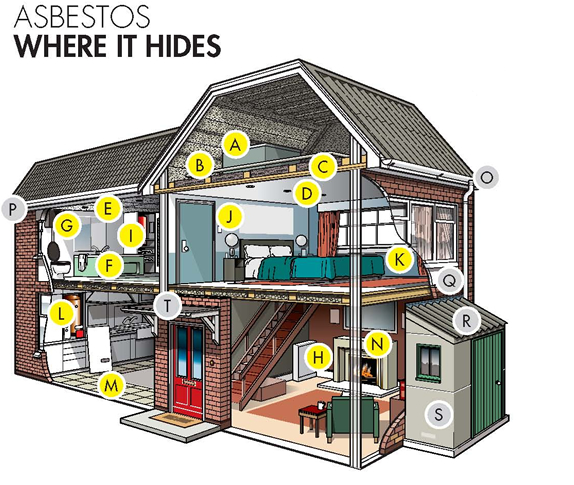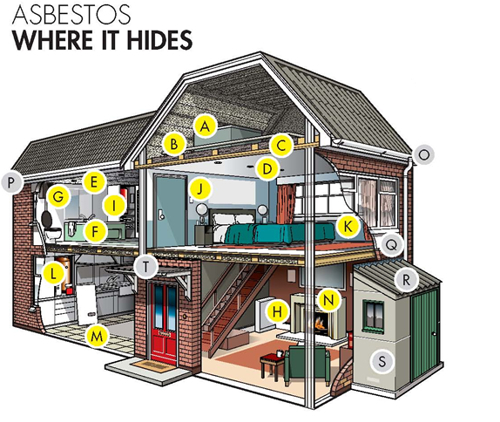What is Asbestos?
Asbestos is a naturally occurring mineral which can be found in rocks all over the world. Asbestos fibres are strong, flexible and have excellent fire proofing and insulating qualities.
Background
Asbestos was commonly added to building materials because of these qualities. Most homes built between 1930s and 1990s feature some building products with Asbestos Containing Materials (ACMs). Its use in the construction industry was finally banned in the UK in 1999.
If your home was built after this date, it is very unlikely to contain asbestos.
The three types of asbestos used in the UK were:
- Amosite (Brown asbestos)
- Chrysotile (White asbestos)
- Crocidolite (Blue asbestos)
You can’t tell a material contains asbestos with the naked eye which is why samples are examined under a microscope at a laboratory. If you’re not sure if a material contains asbestos, contact us and we can advise.
Where asbestos could be located within residential properties (This diagram/list is not exhaustive).

If you need to dispose of old items in your home such as cookers that you suspect contain asbestos, please contact your local authority for details on how to remove and dispose of such items.
Asbestos-containing materials (ACMs) are generally safe if the material is not damaged, and the fibres aren’t disturbed.
I think I've found damaged asbestos, what do I do?
- Do not attempt to clean it up or repair it yourself
- Do not brush or vacuum as this will spread the fibres into the air
- Contact us for advice.
Carrying out DIY works in your home
DIY work can result in exposed risk, whilst it may only be brief it could increase over time. This includes drilling, sanding, or sawing which may disturb the materials. When materials that contain asbestos are disturbed or damaged, fibres are released into the air. When these fibres are inhaled, they can cause serious diseases. You should inform us before starting any work, so that we can provide asbestos information.
More information about the health effects of asbestos exposure can be found on the Health and Safety Executive website.
Carrying out works which do not fall under DIY
You should not carry out activities such as jet washing on roofing panels, soffits, downpipes etc that you suspect may contain asbestos. If in doubt, please check with us first so we can advise whether it’s safe to proceed.
Major Works
You should ask us for approval if you are planning major work in your home. If you think asbestos is present, we can offer advice. However, if alterations are of your own undertaking, then any costs of removing asbestos if it is found will be yours. Major Works may include removal of fireplaces, removal of floor tiles, removing textured coating to plasterboard etc.
Decorating
Some textured ceiling coatings, Artex for example, are known to contain a small quantity of asbestos. Do not attempt to remove them especially with power tools. We can provide advice, so contact us.
How Hyde manages asbestos in your home
We have a duty to manage asbestos in the communal areas of our buildings. We also carry out surveys in individual dwellings when a property becomes empty or before our contractors do some types of works in your property.
We have several options if we find asbestos and will pick the best one for your safety and to ensure any works in your property can be completed:
- Leave in place - often the best and safest option.
- Removal - we’ll remove asbestos for essential works to be carried out
- Encapsulation - this is where a special coating is applied to the material.
Leaseholders’ responsibilities for asbestos removal
Please refer to your lease which will inform you of your responsibilities.
Further information on asbestos is available on the HSE website.
